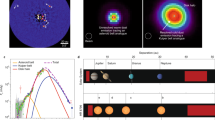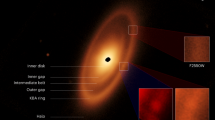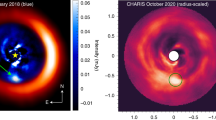Abstract
In the 1980s, excess infrared emission was discovered around main-sequence stars; subsequent direct-imaging observations revealed orbiting disks of cold dust to be the source1. These ‘debris disks’ were thought to be by-products of planet formation because they often exhibited morphological and brightness asymmetries that may result from gravitational perturbation by planets. This was proved to be true for the β Pictoris system, in which the known planet generates an observable warp in the disk2,3,4,5. The nearby, young, unusually active late-type star AU Microscopii hosts a well-studied edge-on debris disk; earlier observations in the visible and near-infrared found asymmetric localized structures in the form of intensity variations along the midplane of the disk beyond a distance of 20 astronomical units6,7,8,9. Here we report high-contrast imaging that reveals a series of five large-scale features in the southeast side of the disk, at projected separations of 10–60 astronomical units, persisting over intervals of 1–4 years. All these features appear to move away from the star at projected speeds of 4–10 kilometres per second, suggesting highly eccentric or unbound trajectories if they are associated with physical entities. The origin, localization, morphology and rapid evolution of these features are difficult to reconcile with current theories.
This is a preview of subscription content, access via your institution
Access options
Subscribe to this journal
Receive 51 print issues and online access
$199.00 per year
only $3.90 per issue
Buy this article
- Purchase on Springer Link
- Instant access to full article PDF
Prices may be subject to local taxes which are calculated during checkout




Similar content being viewed by others
References
Smith, B. A. & Terrile, R. J. A circumstellar disk around β Pictoris. Science 226, 1421–1424 (1984)
Mouillet, D., Larwood, J. D., Papaloizou, J. C. B. & Lagrange, A. M. A planet on an inclined orbit as an explanation of the warp in the β Pictoris disc. Mon. Not. R. Astron. Soc. 292, 896–904 (1997)
Augereau, J. C., Nelson, R. P., Lagrange, A. M., Papaloizou, J. C. B. & Mouillet, D. Dynamical modeling of large scale asymmetries in the β Pictoris dust disk. Astron. Astrophys. 370, 447–455 (2001)
Lagrange, A.-M. et al. The position of β Pictoris b position relative to the debris disk. Astron. Astrophys. 542, A40 (2012)
Nesvold, E. R. & Kuchner, M. J. A SMACK model of colliding planetesimals and dust in the β Pictoris debris disk: thermal radiation and scattered light. Preprint at http://arxiv.org/abs/1506.07187 (2015)
Liu, M. C. Substructure in the circumstellar disk around the young star AU Microscopii. Science 305, 1442–1444 (2004)
Metchev, S. A., Eisner, J. A., Hillenbrand, L. A. & Wolf, S. Adaptive optics imaging of the AU Microscopii circumstellar disk: evidence for dynamical evolution. Astrophys. J. 622, 451–462 (2005)
Krist, J. E. et al. Hubble Space Telescope Advanced Camera for Surveys coronagraphic imaging of the AU Microscopii debris disk. Astron. J. 129, 1008–1017 (2005)
Fitzgerald, M. P., Kalas, P. G., Duchêne, G., Pinte, C. & Graham, J. R. The AU Microscopii debris disk: multiwavelength imaging and modeling. Astrophys. J. 670, 536–556 (2007)
Robinson, R. D., Linsky, J. L., Woodgate, B. E. & Timothy, J. G. Far-ultraviolet observations of flares on the dM0e star AU Microscopii. Astrophys. J. 554, 368–382 (2001)
Mamajek, E. E. & Bell, C. P. M. On the age of the β Pictoris moving group. Mon. Not. R. Astron. Soc. 445, 2169–2180 (2014)
Kalas, P., Liu, M. C. & Matthews, B. C. Discovery of a large dust disk around the nearby star AU Microscopii. Science 303, 1990–1992 (2004)
Augereau, J. C. & Beust, H. On the AU Microscopii debris disk. Astron. Astrophys. 455, 987–999 (2006)
Roberge, A., Weinberger, A. J., Redfield, S. & Feldman, P. D. Rapid dissipation of primordial gas from the AU Microscopii debris disk. Astrophys. J. 626, L105–L108 (2005)
Schneider, G. et al. Probing for exoplanets hiding in dusty debris disks: disk imaging, characterization, and exploration with HST/STIS multi-roll coronagraphy. Astron. J. 148, 59 (2014)
Beuzit, J.-L. et al. SPHERE: a ‘Planet Finder’ instrument for the VLT. In Proc. SPIE Conf. Ser., 7014, 18 (Society of Photo-Optical Instrumentation Engineers, 2008)
Baudoz, P. et al. The differential tip-tilt sensor of SPHERE. In Proc. SPIE Conf. Ser, 7735, 5 (Society of Photo-Optical Instrumentation Engineers, 2010)
Lafrenière, D., Marois, C., Doyon, R., Nadeau, D. & Artigau, E. A new algorithm for point-spread function subtraction in high-contrast imaging: a demonstration with angular differential imaging. Astrophys. J. 660, 770–780 (2007)
Soummer, R., Pueyo, L. & Larkin, J. Detection and characterization of exoplanets and disks using projections on Karhunen-Loève eigenimages. Astrophys. J. 755, L28 (2012)
Milli, J. et al. Impact of angular differential imaging on circumstellar disk images. Astron. Astrophys. 545, A111 (2012)
Chabrier, G., Baraffe, I., Allard, F. & Hauschildt, P. Evolutionary models for very low-mass stars and brown dwarfs with dusty atmospheres. Astrophys. J. 542, 464–472 (2000)
Baraffe, I., Chabrier, G., Barman, T. S., Allard, F. & Hauschildt, P. H. Evolutionary models for cool brown dwarfs and extrasolar giant planets. The case of HD 209458. Astron. Astrophys. 402, 701–712 (2003)
Thalmann, C. et al. Imaging of a transitional disk gap in reflected light: indications of planet formation around the young solar analog LkCa 15. Astrophys. J. 718, L87–L91 (2010)
Moór, A. et al. ALMA continuum observations of a 30 Myr old gaseous debris disk around HD 21997. Astrophys. J. 777, L25 (2013)
Muto, T. The structure of a self-gravitating protoplanetary disk and its implications for direct imaging observations. Astrophys. J. 739, 10 (2011)
Weiss, J. W., Porco, C. C. & Tiscareno, M. S. Ring edge waves and the masses of nearby satellites. Astron. J. 138, 272–286 (2009)
Kral, Q., Thébault, P., Augereau, J. C., Boccaletti, A. & Charnoz, S. Signatures of massive collisions in debris discs. A self-consistent numerical model. Astron. Astrophys. 573, A39 (2015)
Kivelson, M. G. & Southwood, D. J. Dynamical consequences of two modes of centrifugal instability in Jupiter’s outer magnetosphere. J. Geophys. Res. 110, A12209 (2005)
Fendt, C. Magnetically driven outflows from Jovian circum-planetary accretion disks. Astron. Astrophys. 411, 623–635 (2003)
Acknowledgements
SPHERE was built by a European consortium led by IPAG (France). SPHERE was funded by the ESO, with additional contributions from CNRS, MPIA, INAF, FINES and NOVA. SPHERE also received funding from the European Commission FP6 and FP7 programmes as part of OPTICON under grant numbers RII3-Ct-2004-001566 (FP6), 226604 (FP7) and 312430 (FP7). French co-authors are supported by ANR-14-CE33-0018. Part of this work has been carried out within the framework of the National Centre for Competence in Research PlanetS supported by the Swiss National Science Foundation. C.T. and M.R.M. acknowledge the financial support of the SNSF.This study is based on observations from program 60.A-9249(C) at ESO Very Large Telescope and from program number 12228 made with the NASA/ESA Hubble Space Telescope, obtained at STScI, which is operated by AURA Inc. under NASA contract NAS 5-26555. We are also grateful to the ESO for releasing the commissioning data for publication. Finally, we thank P. Zarka, N. Meyer-Vernet, B. Stelzer and Q. Kral for discussions. J.S. is a NASA Postdoctoral Program Fellow.
Author information
Authors and Affiliations
Contributions
A.B. reduced and analysed IRDIS data and wrote the paper. C.T. reduced the IRDIS and ZIMPOL data and contributed to the manuscript writing. A.B., C.T., A.-M.L., M.J., J.-C.A., G.S., C.G., J.D., D.M., T.H., C.D., C.G., J.O. and J.S. worked on the interpretation of the results. G.S., C.G., J.D., D.H., T.R. and J.W. re-reduced HST data. J.M., M.L., D. Mouillet., D. Mawet, J.H.G. and Z.W. operated the instrument at the telescope. A.-L.M. worked on the astrometric calibration. A.B., A.-M.L, M.L., D. Mouillet, T.H., J.-L.B., K.D., M.F., T.F., M.K., F.M., M.M., C.M., J.-F.S, H.M.S, M.T., S.U, F.V. and A.V. contributed to the instrument conception. All authors commented on the manuscript.
Corresponding author
Ethics declarations
Competing interests
The authors declare no competing financial interests.
Extended data figures and tables
Extended Data Figure 1 Limit of detection to point sources.
The contrast is measured at 5σ using fake planets introduced to the data at discrete positions (circles) along the disk midplane to account for the self-subtraction of the ADI/KLIP algorithm. The dashed line defines the edge of the coronagraphic mask at 0.09″.
Extended Data Figure 2 Comparison of IRDIS and ZIMPOL images.
a and b show zoomed-in regions of the KLIP and LOCI reductions of the IRDIS infrared data, whereas c is taken from the conservative LOCI reduction of the ZIMPOL optical data. Features A and B are reproduced accurately in the ZIMPOL data. An additional substructure between feature B and the midplane is also detected, as indicated by arrows. The yellow star symbol indicates the position of the star.
Extended Data Figure 3 Spine of the disk measured in SPHERE IRDIS data.
The spine is measured using several reductions (noADI, ADI, KLIP) of the SPHERE IRDIS 2014 data. Average values and dispersions (error bars) are plotted as a blue line. For each region where a local maxima is identified, a Gaussian + first-order polynomial model is fitted in order to register precisely the five features.
Extended Data Figure 4 Central part of the SPHERE IRDIS image.
a shows a 12″ field of view of the SPHERE IRDIS image processed with the KLIP algorithm and b is a magnified version to indicate the bow-like deviation of the disk to the southeast in the central area (for separations shorter than ~0.7″). The horizontal dotted lines indicate the disk midplane.
Extended Data Figure 5 Positions of the disk features over time.
The positions of the features measured in the SPHERE and HST images are plotted as circles together with peak-to-valley error bars (in some cases, the errors are smaller than the symbol size). Linear fits on these three epochs illustrate the possible track of each feature. The black symbols show the location at which various inhomogeneities were reported in the literature, on the basis of older data6,7,8,9. The colour coding is the same as in Fig. 4.
Rights and permissions
About this article
Cite this article
Boccaletti, A., Thalmann, C., Lagrange, AM. et al. Fast-moving features in the debris disk around AU Microscopii. Nature 526, 230–232 (2015). https://doi.org/10.1038/nature15705
Received:
Accepted:
Published:
Issue Date:
DOI: https://doi.org/10.1038/nature15705
This article is cited by
-
Astrophotonics: astronomy and modern optics
The Astronomy and Astrophysics Review (2021)
-
A planet within the debris disk around the pre-main-sequence star AU Microscopii
Nature (2020)
-
The truth about exoplanets
Nature (2016)
-
Surprisingly fast motions in a dust disk
Nature (2015)
Comments
By submitting a comment you agree to abide by our Terms and Community Guidelines. If you find something abusive or that does not comply with our terms or guidelines please flag it as inappropriate.



